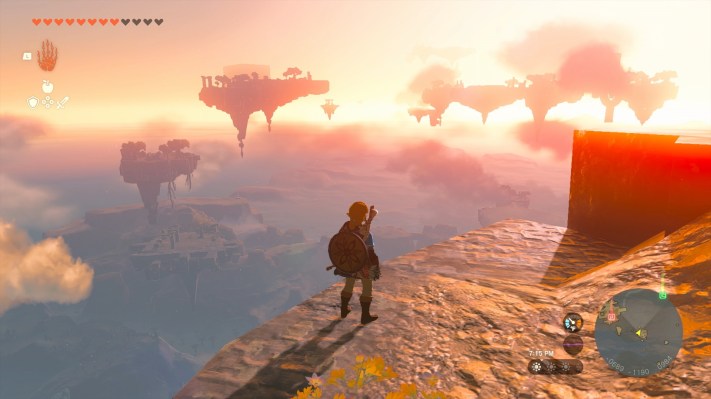Breath of the Wild never ends. It just sort of sputters to a halt. You spend weeks or months preparing for that final climactic battle, and when you’re ready, you go head-to-head with the giant, shape-shifting fiery bearded spider-crab crab, only to be dropped back out into open-world Hyrule at your last save point. It’s a frustrating and wildly anti-climactic end to what is otherwise one of the most epic and satisfying games of recent vintage.
One can compellingly (and, I think, correctly) make the argument that the debut Nintendo Switch title is one of the medium’s all-time masterpieces. But that end. You can pick up where you left off and take on Calamity Ganon again. Maybe do it with a worse weapon this time or less armor or fewer hearts. Maybe speed-run the thing. Go viral. But we both know it will never be the same as the first time.
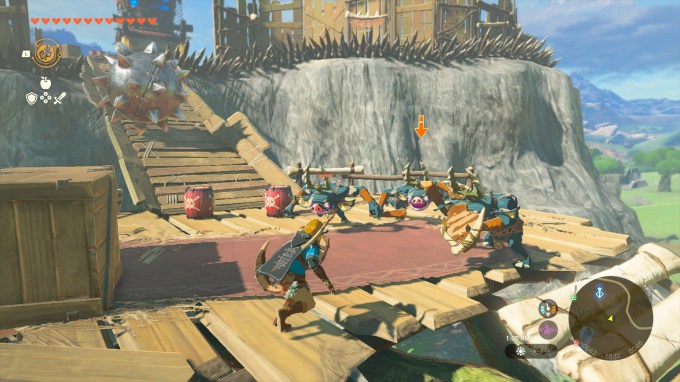
Image Credits: Nintendo
There’s a lesson to be found in all of this. You know the deal. It’s the journey, not the destination. Anyone who’s watched all six seasons of The Sopranos can tell you that even the greatest stories of all time can fail to stick the landing. But fading to black on a Journey song will never rob you of Christopher’s final season arc.
A thing you learn pretty quickly about BOTW is something that is true of all great art: Everyone experiences it differently. The spectrum of difference feels somehow infinitely great with open-world, interactive art. One can, by the very nature of the medium, experience it as an altogether different work. I know multiple people who gave up on main and side quests outright, and were perfectly happy to while away hours exploring Hyrule on horseback. I respect that. It tickles the synapses in an extremely pleasing way.
For me, the game took on outsized meaning. I began playing it in earnest three years ago this month. Stuck inside a one-bedroom Queens apartment, battling unrelated health issues at the height of the global pandemic, I gave myself up to the game in a way I haven’t since I was a kid. I happily let it eat up long hours. What choice did I have? I let it be my sourdough baking, my Animal Crossing.
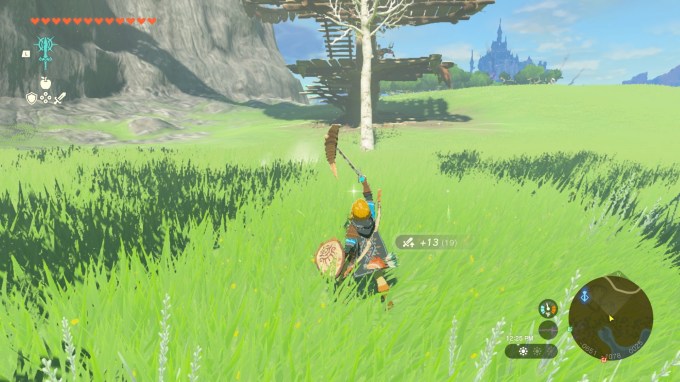
Image Credits: Nintendo
I felt weirdly empty when it ended. I played the downloadable content. I tried other games. Nothing scratched that itch. I did the Zelda remasters. Playing Hyrule Warriors: Age of Calamity was a nice bit of hack and slash with none of the depth. Can’t fault it for that. That was kind of the point.
If you’re reading this far, I probably don’t need to tell you about the little electric zap the first Tears of the Kingdom trailer gave me back at E3 2021 (Eric Clapton Unplugged-sounding name aside). It was similar but — one hoped — different enough to draw us all back in. I don’t think I was alone in my skepticism, either. For one thing, the game started life as another bit of DLC. Nintendo has been upfront about this fact.
“When we released the DLC for Breath of the Wild, we realized that this is a great way to add more elements to the same world,” series producer Eiji Aonuma told Kotaku at the time. But when it comes down to technical things, DLC is pretty much data — you’re adding data to a preexisting title,” Aonuma added. “And so when we wanted to add bigger changes, DLC is not enough, and that’s why we thought maybe a sequel would be a good fit. “Initially we were thinking of just DLC ideas, but then we had a lot of ideas and we said, ‘This is too many ideas, let’s just make one new game and start from scratch.'”
Fair enough. But there’s still a lot of daylight between too much for a DLC and enough for a standalone game — especially when the bar from that game is one as expansive as Breath of the Wild.
Last week, Nintendo held a series of small briefings offering a limited preview of the game. According to the company, we were the first people outside of Nintendo to play the BOTW sequel. Given the size, scope and length of time I was able to play, I cannot with any confidence claim to know how Tears of the Kingdom compares to its predecessor, nor would I deign to try. I can, however, tell you two things.
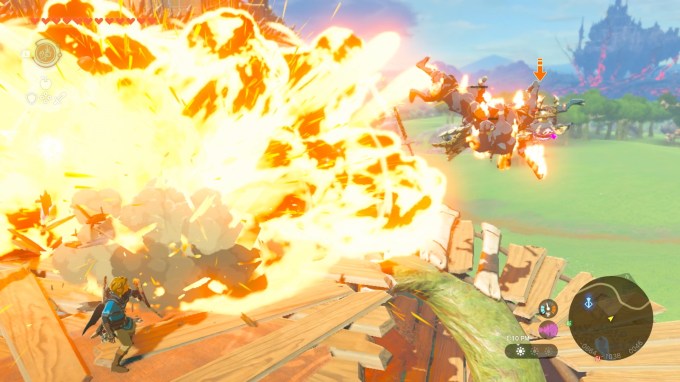
Image Credits: Nintendo
First, it will suck you in, so steel yourself for that. TechCrunch had held a small, unrelated event in the city that night, and it took me a while to come back down to Earth — not a dissimilar feeling from how I felt after long BOTW marathons. Second, the game is designed with replayability at its core. You could beat Calamity Ganon in the predecessor and still play and discover new things forever, if you so chose. Many a game site juiced its SEO with lists centered around all of the things you could/should do once to “beat” the game.
The excitement was palpable among Nintendo employees during the briefing. It didn’t feel canned or put on — not something I can say in most of the briefings I take. The reporters were broken into small groups, with a few attending Nintendo employees at each. In a first demo designed to get a feel for the game, I solved the small problem of getting a mining cart across a gap in a rail by fusing two fans at perpendicular angles. The first propelled it forward, while it kept the moving cart just upright enough to make it to the other side.
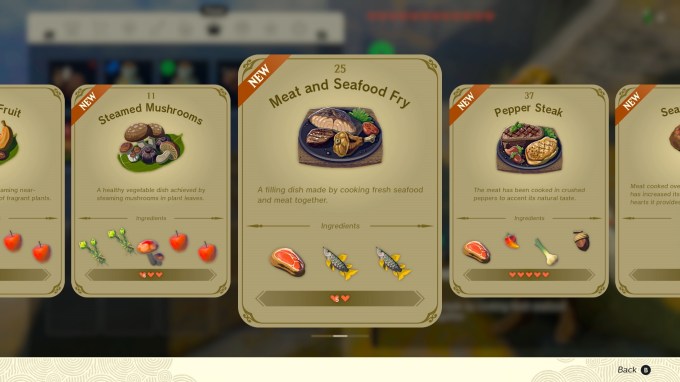
Image Credits: Nintendo
Cheers and high fives all around. Imagine coming to work each day with that energy. It truly boggles the mind. It’s also unquestionably great to have praise directed your way when you solve a problem in a novel way no one in the room has seen before. You start gathering materials and the person next to you gives a sly wink and says, “I like where this is going.” Sometimes it works as planned, but more often than not, it doesn’t.
Tears of the Kingdom is a game about solving problems. Imagine all of those dungeon puzzles being a foundational part of BOTW. They played a role in the game, but they never felt like the game itself. Again, I can’t speak to the size and scope of the game just yet, but I can say that the demos were very deliberately structured around Link’s new abilities — Recall, Fuse, Ultrahand and Ascend — and the way the skill sets can be used and combined to overcome obstacles.
In the demo, none of the puzzles felt remotely as formal as the kind found in the predecessor’s dungeons. They’re far more organically woven into the fabric of Hyrule, to the extent that you often aren’t aware of them until you can’t go any further. Replayability is in the fabric in the sense that there is generally no “right” or “wrong” way to solve problems — there are those solutions that work and those that don’t. Thankfully, Recall is one of the abilities, so the stakes of failure are generally low. At the very worst, it means returning to the last save point.
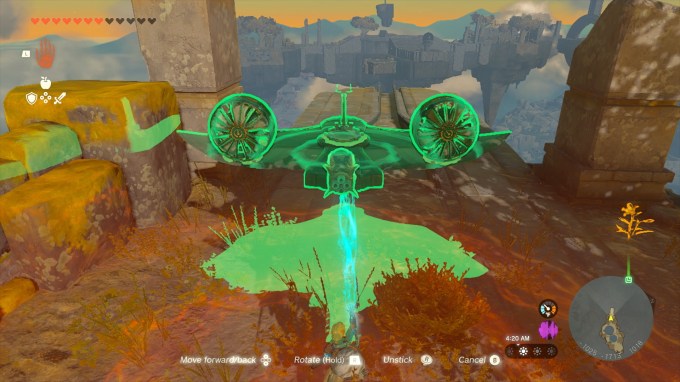
Image Credits: Nintendo
For the sake of clarity, here are Link’s different abilities as described by Nintendo:
Ultrahand: Using the new Ultrahand ability, Link can pick up, move and rotate objects. He can even attach things together to create bridges, vehicles and more!
Fuse: Magically fuse objects to Link’s current weapon, shield or arrow to increase durability, damage or even add a new effect. Experiment with lots of different combinations to come up with surprising — and sometimes hilarious — results!
Ascend: Add a new dimension to your exploration with Ascend, which gives Link the ability to pass through solid objects above him. Rise up through ceilings, hillsides and even certain enemies to create seemingly impossible shortcuts.
Recall: Use Recall to reverse an object’s movement, letting Link ride fallen boulders skyward, recover thrown weapons or send projectiles back where they came from.
You’ll note that there’s an additional icon in the radial abilities menu that’s not listed above or in the material Nintendo has released thus far. I can’t go into a lot of detail here, but I can tell you it’s something that combines well with the Ultrahand feature to streamline the process of building things.
The task, as laid out by our Nintendo handlers, was to first reach the Avatar/Pandora-style floating islands above and then navigate across them. Easier said than done, right? There were, naturally, a bunch of giant monsters, massive walls and a makeshift fortress standing in your way. The immediate setup will prove familiar if you spent any time in the BOTW’s Hyrule: a small tree fortress surrounded bat-eared Bokoblins and their bigger, skinnier cousins, the Moblins.
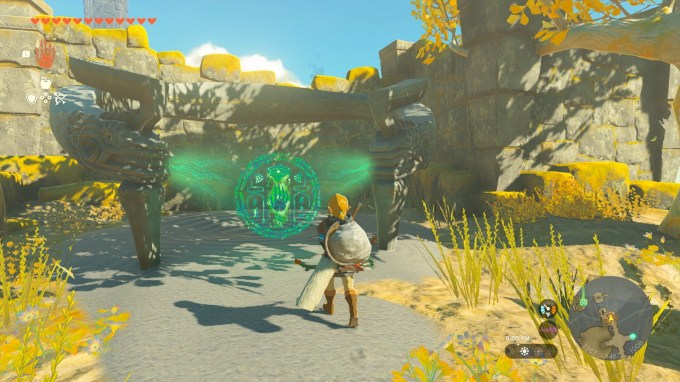
Image Credits: Nintendo
The muscle memory returns quickly. It takes a little finessing, depending on how long it’s been since you last stepped foot in Hyrule, but it all comes flooding back soon enough. The inventory system is effectively the same, but expanded. For the sake of the demo, Nintendo loaded up with accessories that would ease up back into combat.
Extrapolating from this limited game play, I suspect that Fuse is going to be most people’s most frequent go to (it certainly was mine) — both in the problem-solving aspects, but also the standard game play. For example, someone discovered during one of the playthroughs that fusing a ruby to a weapon both lets you do fiery attacks and helps keep you warm in snowy areas. A simpler example is fusing a rock to a sword to reinforce the weapon as — just like BOTW — these things break down the more you use them.
Those elements brought the breadth of the game into a sharper focus. Surprisingly, the possibilities feel even more endless than their predecessor. I freely admit that when Nintendo first mentioned the full-blown sequel was born out of suggestions for a DLC, I had doubts that this stuff could be stretched into a full-blown, legitimate sequel to one of the greatest games of the decade. Once you start trying different combinations, however, you begin to understand what the company meant when it said there were just too many ideas to just exist as a BOTW add-on. This stuff spirals pretty quickly.
[gallery ids="2533962,2533987,2533986,2533985,2533984,2533983,2533982,2533981,2533980,2533979,2533978,2533977,2533976,2533975,2533974,2533973,2533972,2533970,2533969,2533968,2533967,2533966,2533965,2533964,2533963"]
The puzzles themselves took all manner of different forms in the relatively short preview. Often times, they’re the seemingly simple challenge of getting from point A to point B. As more complexities present themselves, you’ll undoubtedly find yourself grafting together more complex solutions.
Fuse, again, is the fundamental ability underscoring much of this, while Ultrahand is used to put them in the correct orientation. For example, getting a raft across a river without wind or a paddle might require grabbing and placing a pair of fans or rockets on the back. Obviously you’re going to want them facing the right way to have the desired effect. Now say something was off and the raft is seemingly irretrievable. Hit it with Recall to reverse the object’s last action. I had a few instances where I saved myself or objects from plummeting to sudden doom with the feature. It’s a real lifesaver.
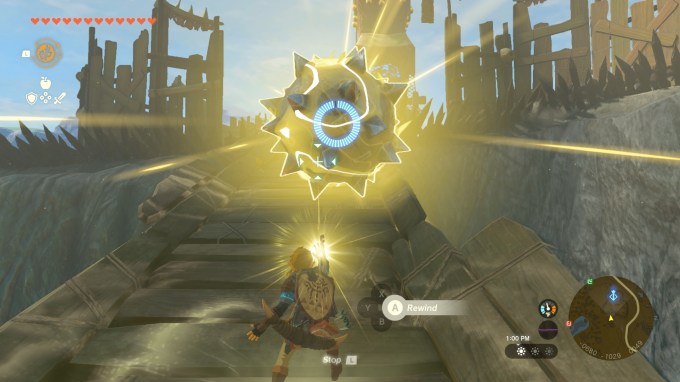
Image Credits: Nintendo
It’s clear to see how recall could be used in other clever ways. Take the recently released game play demo, which features a rock falling off one of the sky islands. Hit that with Recall and see where it takes you.
Of the four primary abilities, I used Ascend the least during the demo, which is unfortunate, because it may be the most visually compelling of the bunch. Stand beneath a spot with enough clearance, target the ceiling with the feature and suddenly Link appears to be swimming up through the liminal space inside the object. It’s easy to see how this could be an incredibly useful feature, but the opportunity only presented itself a few times for me. I’m sure it will have a ton more functionality, the deeper you get into the game — just be aware that you often emerge among enemies. They’ll freeze as you pop through, but you’re still suddenly in the thick of it.
As you play, you start to feel the sense of scope open up. Breath of the Wild obviously shares the most direct DNA, but elements of Skyward Swords shine throughout, as well, as the game begins to build upward. You quickly get the sense that much of the action and plot is set to play out high above Hyrule, both on and between the islands, as you skydive, paraglide and discover – and create – additional modes of transportation.
The exact plot isn’t entirely clear. Though let’s be real – it’s a Zelda game. The adventure is the thing. Nintendo describes it thusly, “Malevolent forces threaten the kingdom of Hyrule. Harness the power of Link’s new abilities to fight back.” It’s a two sentence synopsis that can effectively be applied to almost every entry in the series. Not a lot to work with there, but the gist is familiar: Link is the last line of defense for Zelda and Hyrule as Ganon closes in. The odds are stacked against him, but our hero is tenacious, hearty and has a sweet sword.
Of the three trailers, number two seems to offer the most insight here. A blood moon hangs over Hyrule, as (presumably) Ganon’s voice compels his millions to “Eliminate this kingdom and her allies,” adding with a shout, “leave no survivors!” Dark stuff. It turns triumphant quickly, of course, even as pieces of the castle crumble and the dark armies hit full power. Contrary to the doubt Zelda voice, Link’s got this. He rides a horse through the Great Plateau as the music swells.
The third trailer extends the scope and gives us our first good look at Ganon, as well as battle with a Stone Talus. It speaks well to the playability that each subsequent trailer introduces a seemingly endless stream of abilities, weapons, platforms and characters, seemingly putting to rest some of the concerns that we’re getting little more than a reheated version of Breath of the Wild.
Will Tears of the Kingdom actually rival Breath of the Wild? I’m being mindful of the limitations of passing a remotely definitive judgement based on the limited time I spent with the title. It’s like that parable with the elephant. It was a demo of the real game, sure, but it was a supervised one with two key objectives: getting to know the mechanics of Link’s new abilities and spending some time above Hyrule.
There is, I suppose, a compelling argument to made that TOTK almost definitionally can’t rival BOTW because it’s set in such a lived in world. It’s a direct sequel in a game franchise that’s undergone countless foundational rethinks. Short of shelling out the money for one of those Eternal Sunshine of the Spotless Mind machines, you can’t play Breath of the Wild again for the first time.
Zelda, Link, Ganon and Hyrule turned 37 this February. That’s some enduring IP. Certainly some fundamentals of the game have largely remained a constant over the decades, but without the benefit of understanding the evolution and scope of the series, how much would a time travel from the mid-80s really recognize in the game? It’s hardly a knock against the series – in fact, much like his coworker Mario, Link’s transformations are among his biggest strengths.
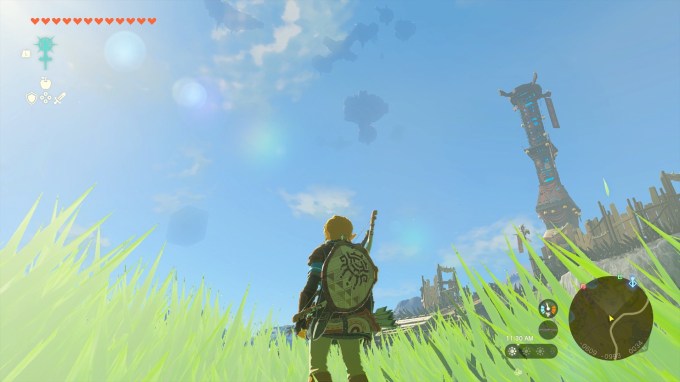
Image Credits: Nintendo
The trailers and demos have clearly demonstrated that there’s plenty of occasion to be wowed, but ultimately Tears of the Kingdom feels more like an extension of Breath than reinvention. Putting myself back in the place of disappointment after besting Ganon a few years back, I’ll happily welcome that with open arms, especially given all of the new creations, physics and settings to explore in an otherwise familiar place.
My own demo went long. I was getting close to solving a final puzzle. We could feel it. Everyone else watched on with a combination of bated breath and suggestions. The stakes are higher when you’re up in the sky, and the infinite fusing combinations turn it into a spectator sport. After trial and error and a lot of hand wringing, I give it one more go, safely making it across the chasm. We can breathe now. The demo is over, but we’ve barely scratched surface.
The Legend of Zelda Tears of the Kingdom arrives May 12.
